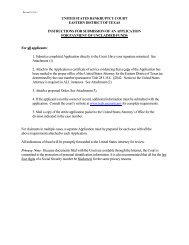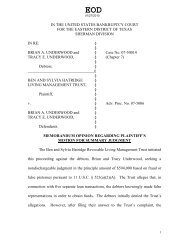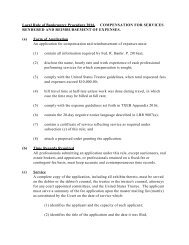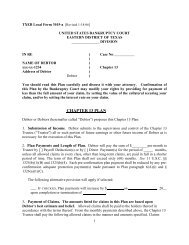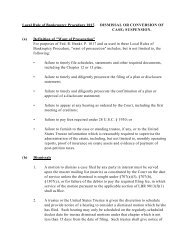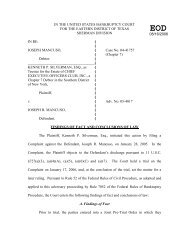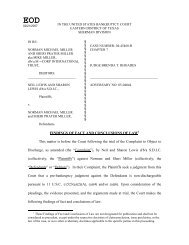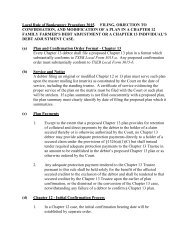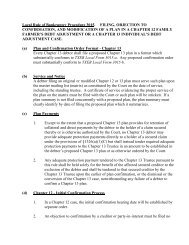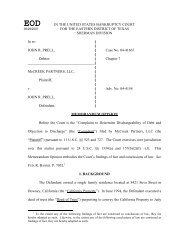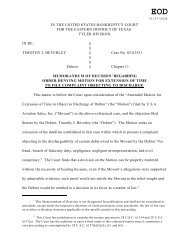memorandum of decision - Eastern District of Texas
memorandum of decision - Eastern District of Texas
memorandum of decision - Eastern District of Texas
You also want an ePaper? Increase the reach of your titles
YUMPU automatically turns print PDFs into web optimized ePapers that Google loves.
EOD01/23/2008IN THE UNITED STATES BANKRUPTCY COURTFOR THE EASTERN DISTRICT OF TEXASTYLER DIVISIONIN RE: §§RANDALL K. LEATH §xxx-xx-1751 § Case No. 06-60393and MARILYN LEATH §xxx-xx-7063 §P.O. Box 1171, Henderson, <strong>Texas</strong> 75653 §§Debtors § Chapter 13MEMORANDUM OF DECISIONThis matter is before the Court to consider the Motion <strong>of</strong> Henderson FederalSavings Bank and <strong>Texas</strong> Bank to Compel Distribution <strong>of</strong> Payments in Accordance withChapter 13 Plan (the “Motion”) filed by Henderson Federal Savings Bank and <strong>Texas</strong>Bank (collectively “Claimants”) in the above-referenced case. The Claimants seek tocompel the payment <strong>of</strong> additional sums <strong>of</strong> money from the Chapter 13 Trustee based upona contention that they are each entitled to the payment <strong>of</strong> additional interest on theirrespective allowed secured claims encompassing the period from the filing date <strong>of</strong> thiscase to the confirmation date. The Trustee objected on the basis that the interest to bepaid through the confirmed plan begins to accrue only at confirmation. At the conclusion<strong>of</strong> the hearing, the Court took the matter under advisement. This <strong>memorandum</strong> <strong>of</strong><strong>decision</strong> disposes <strong>of</strong> all issues pending before the Court. 11 This Court has jurisdiction to consider the Movants’ motion pursuant to 28 U.S.C. §1334(b)and 28 U.S.C. §157(a). The Court has the authority to enter a final order in this contested matter since itconstitutes a core proceeding as contemplated by 28 U.S.C. §157(b)(2)(A), (B), and (O).
BackgroundRandall K. Leath and Marilyn Leath (hereinafter “Debtors”) filed a voluntarypetition for bankruptcy relief under Chapter 13 <strong>of</strong> the United States Bankruptcy Code onJuly 20, 2006. On August 18, 2006, <strong>Texas</strong> Bank filed a single pro<strong>of</strong> <strong>of</strong> claim in theamount <strong>of</strong> $42,373.03 based on two promissory notes arising from two separatetransactions involving the Debtors. On August 25, 2006, Henderson Federal SavingsBank filed a pro<strong>of</strong> <strong>of</strong> claim in the amount <strong>of</strong> $54,716.06, also based on two distinctpromissory notes arising from different transactions. Following an initial denial <strong>of</strong> aproposed plan, the Debtors filed an Amended Chapter 13 Plan on October 26, 2006. Itproposed variable payments by the Debtors over a 60-month period. As to the Claimants'respective claims, the plan proposed to pay those claims in a pro rata distribution amongother secured creditors without specifying a precise payment amount. The monthlypayment amount was simply referenced as “Pro Rata, Month(s) 1-59.” Based uponcertain pre-hearing agreements reached between the Debtors and various objectingcreditors, the Plan was confirmed without objection on January 12, 2007. Theconfirmation order provided under Section IV that “[A]ll creditors having allowedsecured claims (whether filed before or after an Order Confirming Plan is entered) shallbe treated in accordance with section 1325(a)(5), except as otherwise specifically set forthherein.” Consistent with the procedures established by the Court when confirmation wasmandated under BAPCPA to occur prior to the passage <strong>of</strong> the bar date for claims,-2-
1(I)(b) <strong>of</strong> the confirmation order also provided, in part, as follows:The Trustee shall file and serve all parties in interest with the Trustee'sRecommendation Concerning Claims within thirty (30) days <strong>of</strong> the latter <strong>of</strong>entry <strong>of</strong> this Order or the claim filing deadline for all creditors (including agovernment unit). Such Trustee's Recommendation Concerning Claimsshall include the Trustee's objections to claims, if any, recommendations asto the extent and validity <strong>of</strong> each creditor's security interest, if any, andrecommendations as to the value <strong>of</strong> any collateral not previously valued bythe Court.The Trustee subsequently filed his Trustee's Recommendation Concerning Claims(the “TRCC”), which objected to the consolidated manner in which each Claimant hadpresented its two distinct secured claims. In response thereto, each Claimant objected tothe approval <strong>of</strong> the TRCC and eventually split its respective consolidated claim into twoseparate claims. 2With all objections having been resolved, the parties tendered aproposed agreed order to the Court approving the TRCC and the Court entered thatcertain “Order Approving Trustee’s Recommendation Concerning Claims withModification as Set Forth Herein” on April 11, 2007, which provided, in relevant part,that:It is therefore ORDERED, ADJUDGED AND DECREED that theTrustee’s Recommendation Concerning Claims is hereby approved with thefollowing modification:2 <strong>Texas</strong> Bank bifurcated its original pro<strong>of</strong> <strong>of</strong> claim into two separate secured claims in theamounts <strong>of</strong> $23,606.00 and $18,767.03. Likewise, Henderson Federal Savings Bank bifurcated itsoriginal pro<strong>of</strong> <strong>of</strong> claim into two separate secured claims in the amounts <strong>of</strong> $13,468.06 and $41,248.00.-3-
The following claims will be paid in the Plan in the followingmanner consistent with the terms <strong>of</strong> the confirmed Chapter 13Plan:Trustee will pay <strong>Texas</strong> Bank its claim amount <strong>of</strong> $23,606.00as set forth in the amended Court Claim #12-2 and as securedby the collateral as described in said claim (Equipmentincluding 2005 Kubota tractor) on a pro-rata basis at 9%interest over months 1-59.Trustee will pay <strong>Texas</strong> Bank its claim amount <strong>of</strong> $18,767.03as set forth in the amended Court Claim # 12-3 and as securedby the collateral as described in said claim (2005 horse trailerand truck bed) on a pro-rata basis at 9.75% interest overmonths 1-59.Trustee will pay Henderson Federal Savings Bank its claimamount <strong>of</strong> $13,468.06 as set forth in amended Court Claim#14-2 and as secured by the collateral as described in saidclaim (2005 Ford F150 Pickup Truck) on a pro-rata basis at7.99% interest over months 1-59.Trustee will pay Henderson Federal Savings Bank its claimamount <strong>of</strong> $41,248.00 as set forth in amended Court Claim#14-3 and as secured by the collateral as described in saidclaim (2006 Ford F250 Pickup Truck) on a pro-rata basis at9.01% interest over months 1-59. 3On or about May 2, 2007, the Claimants received their first plan distributions fromthe Trustee, which did not include the payment <strong>of</strong> interest as calculated from the petitiondate through the date <strong>of</strong> confirmation. On June 14, 2007, the Claimants filed the presentmotion to compel the Trustee to pay such additional interest for months arising in thepost-petition, pre-confirmation period to which the Trustee timely objected.3 See Order Approving Trustee’s Recommendation Concerning Claims with Modification as SetForth Herein entered on April 11, 2007 (dkt #98).-4-
With limited exceptions, 4 the general rule as to a creditor’s entitlement to postpetitioninterest as a component <strong>of</strong> an allowed claim is that the accrual <strong>of</strong> interest ceasesas <strong>of</strong> the date <strong>of</strong> the filing <strong>of</strong> the bankruptcy petition. This proposition is reflected notonly in numerous bankruptcy and appellate court opinions, see, e.g., Chemical Bank v.First Trust <strong>of</strong> New York, N.A. (In re Southeast Banking Corp.) 179 F.3d 1307, 1309 (11thCir. 1999); Kellogg v. U.S. (In re West <strong>Texas</strong> Marketing Corp.), 54 F.3d 1194, 1197 (5thCir. 1995), but even in <strong>decision</strong>s <strong>of</strong> the United States Supreme Court over the past 100years. U.S. v. Ron Pair Enterprises, Inc., 489 U.S. 235, 246 (1989) [acknowledging “apre-Code rule that the running <strong>of</strong> interest ceased when a bankruptcy petition was filed”];United Sav. Ass'n <strong>of</strong> <strong>Texas</strong> v. Timbers <strong>of</strong> Inwood Forest Associates, Ltd., 484 U.S. 365,372-73 (1988) [recognizing the general rule disallowing post-petition interest onundersecured claims and finding that “[S]ection 506(b)'s denial <strong>of</strong> postpetition interest toundersecured creditors merely codified pre-Code bankruptcy law, in which that denialwas part <strong>of</strong> the conscious allocation <strong>of</strong> reorganization benefits and losses betweenundersecured and unsecured creditors.”]; Vanston Bondholders’ Protective Committee v.4 The payment <strong>of</strong> post-petition interest is generally allowed only in the limited (and unusual)circumstances in which: (1) under §506(b), the value <strong>of</strong> a creditor’s collateral exceeds the amount <strong>of</strong> itsclaim; or (2) when the liquidation <strong>of</strong> the debtor under Chapter 7 reveals a state <strong>of</strong> solvency wherein,under §726(a)(5), such unexpected proceeds in excess <strong>of</strong> the aggregate amount <strong>of</strong> allowed claims aredistributed as interest at the legal rate to the creditor body rather than being returned to the debtor. Athird exception, when a creditor’s collateral generates income in the post-petition period, was recognizedin pre-Code jurisprudence but its viability today has been seriously questioned. See Dean Powlowic,Entitlement to Interest under the Bankruptcy Code, 12 BANKR. DEV. J. 149 (1995). Regardless, neither<strong>of</strong> the latter two exceptions are applicable to the current dispute and, as explained below, the application<strong>of</strong> §506 for the allowance <strong>of</strong> post-petition interest is precluded in this context through the application <strong>of</strong>§1325(a)(*).-6-
Green, 329 U.S. 156, 163 (1946) [“The general rule in bankruptcy and in equityreceivership has been that interest on the debtors' obligations ceases to accrue at thebeginning <strong>of</strong> proceedings.”]; Sexton v. Dreyfus, 219 U.S. 339, 344 (1911). 5Since the adoption <strong>of</strong> the Bankruptcy Code, this general rule as to the impact <strong>of</strong>interest in the determination <strong>of</strong> an allowed claim has been implemented through 11U.S.C. §502(b), which directs a court to determine the amount <strong>of</strong> a claim “as <strong>of</strong> the date<strong>of</strong> the filing <strong>of</strong> the petition.” That statutory directive thereby authorizes, in the calculation<strong>of</strong> an allowed claim, the inclusion <strong>of</strong> all interest which accrued on the underlyingobligation prior to the petition date, but it implicitly excludes any interest which wouldhave, in the absence <strong>of</strong> the bankruptcy petition, continued to accrue on that debtsubsequent to that petition date. To the extent that further confirmation <strong>of</strong> thatprohibition was needed, the exclusion <strong>of</strong> post-petition interest in the composition <strong>of</strong> anallowed claim is then overtly stated in §502(b)(2), which makes any claim for unmaturedinterest (as <strong>of</strong> the petition date) a specifically-enumerated ground for objection to theallowance <strong>of</strong> that claim.Thus, in the absence <strong>of</strong> an applicable exception, the payment <strong>of</strong> post-petition5 In that case, Mr. Justice Holmes noted the following:Sexton, 219 U.S. at 344.We take our bankruptcy system from England, and we naturally assumethat the fundamental principles upon which it was administered wereadopted by us when we copied the system, somewhat as the establishedconstruction <strong>of</strong> a law goes with the words where they are copied byanother state. No one doubts that interest on unsecured debts stops.-7-
interest as a component <strong>of</strong> an allowed claim is statutorily precluded. While the Claimantsunder different circumstances might have invoked the exception provided in §506(b) forthe payment <strong>of</strong> post-petition interest to an oversecured creditor, that exception wasrendered unavailable to the Claimants in this instance because the Plan as confirmedapplied the provisions <strong>of</strong> §1325(a)(*) to these claims, thereby precluding any reference to§506 in its entirety. As a result, while the invocation <strong>of</strong> §1325(a)(*) protected theseclaims from bifurcation under §506(a), its broad prohibition also had an unintendednegative consequence as to these Claimants — it preempted any application <strong>of</strong> §506(b) tothese claims, thereby eliminating any right that these Claimants might have otherwisepossessed to the payment <strong>of</strong> post-petition, pre-confirmation interest on these claims. 6SeeDavid Carlson, Cars and Homes in Chapter 13 after the 2005 Amendments to theBankruptcy Code, 14 AM. BANKR. INST. L. REV. 301, 348 (2006) [noting that theapplication <strong>of</strong> §1325(a)(*) to a claim would not only preclude any reference to §506(b)for any entitlement to post-petition interest by an oversecured lender, but that such lendercould never show that it was oversecured in any event since “the thrust <strong>of</strong> the hangingparagraph is that the value <strong>of</strong> the [collateral] always equals the amount that is owed.”].Though the application <strong>of</strong> §1325(a)(*) blocks any access to the rights outlined in §506, all6 Though stated otherwise in the pro<strong>of</strong>s <strong>of</strong> claim, the Claimants asserted at the hearing that theclaim amounts did not actually contain any calculation <strong>of</strong> post-petition, pre-confirmation interest. Theydid, however, acknowledge that the claim amounts included an assessment <strong>of</strong> post-petition attorneys’fees. However, those issues are outside the scope <strong>of</strong> this dispute since no party objected to the claimamounts within the time period set by the Court.-8-
other statutory provisions, including those in §502, remain applicable. Therefore, becausethere is no exception available in these circumstances, the general rule applies, and anyentitlement asserted by these Claimants to the payment <strong>of</strong> post-petition interest from thedate <strong>of</strong> the bankruptcy petition to the date <strong>of</strong> confirmation is statutorily precluded by theprovisions <strong>of</strong> the Bankruptcy Code.Since these Claimants cannot compel the payment <strong>of</strong> post-petition interest as acomponent <strong>of</strong> their claims, the only other foundation upon which their demand on theTrustee can be based is the payment <strong>of</strong> post-confirmation interest — that is, the interestrequired to be paid in order to meet the confirmation standards <strong>of</strong> §1325(a). Specifically,unless the creditor accepts the plan or the debtor surrenders the collateral tothe creditor, §1325(a)(5)(B)(ii) guarantees that property distributed under aplan on account <strong>of</strong> a claim, including deferred cash payments in satisfaction<strong>of</strong> the claim must equal the present dollar value <strong>of</strong> such claim as <strong>of</strong> theconfirmation date. . . . [s]ection 1325(a)(5)(B) requires all holders <strong>of</strong>allowed secured claims to be paid the present value <strong>of</strong> such claims, whichimplies the payment <strong>of</strong> interest.Rake, 508 U.S. at 469-70. This assessment <strong>of</strong> post-confirmation interest is required inrecognition <strong>of</strong> the fact that “a debtor’s promise <strong>of</strong> future payments is worth less than animmediate payment <strong>of</strong> the same total amount because the creditor cannot use the moneyright away, inflation may cause the value <strong>of</strong> the dollar to decline before the debtor pays,and there is always some risk <strong>of</strong> nonpayment.” Till v. SCS Credit Corp., 541 U.S. 465,474 (2004). Thus, in recognition <strong>of</strong> the time-value <strong>of</strong> money, a debtor who seeks to pay-9-
an allowed secured claim through a stream <strong>of</strong> future installment payments, in lieu <strong>of</strong>tendering the entire amount <strong>of</strong> the claim on the effective date <strong>of</strong> the plan, is required todiscount that stream <strong>of</strong> payments to a present value that is not less than the allowedamount <strong>of</strong> the secured claim. This is accomplished by applying an appropriate rate <strong>of</strong>interest to the allowed amount <strong>of</strong> the claim so that the creditor receives an amountequivalent to the amount that the creditor would have received if its claim had been paidas <strong>of</strong> the effective date <strong>of</strong> the plan. Key Bank v. Harko (In re Harko), 211 B.R. 116, 119-20 (B.A.P. 2d Cir. 1997); See generally 7 NORTON BANKRUPTCY LAW & PRACTICE 3d§151:14 at p.151-89 (2008); 2 KEITH M. LUNDIN, CHAPTER 13 BANKRUPTCY 111.1 at p.111-1 (3d ed. 2000 & Supp. 2004). However, because the Claimants’ position would beinconsistent with the specific purpose for which any post-confirmation interest is requiredin this context, the payment <strong>of</strong> post-confirmation interest on an allowed secured claimpursuant to a confirmed plan <strong>of</strong> reorganization, as a matter <strong>of</strong> law, could only begin toaccrue as <strong>of</strong> the effective date <strong>of</strong> the confirmed plan. 7To hold otherwise would result inthe receipt by secured creditors <strong>of</strong> more interest than the amount necessary to preserve thepresent value <strong>of</strong> their claims, to the detriment <strong>of</strong> junior creditors. As stated in In re7 Since the confirmed plan in this case did not identify a precise date to be used as the effectivedate <strong>of</strong> the plan, it appears that the Trustee, apparently for ease <strong>of</strong> reference, simply chose theconfirmation date as the date from which the interest payments should be calculated, even though itwould appear as if the earliest date which could technically serve as the effective date <strong>of</strong> the plan wouldbe the date upon which a confirmation order could become final and unappealable and therefore bindingupon all parties under §1327. However the difference in those two sums would likely be negligible. Seegenerally, 8 COLLIER ON BANKRUPTCY 1325.06[3][b][i] at p. 1325-35 (15th ed. rev. 2007).-10-
Denton, 370 B.R. 441 (Bankr. S.D. Ga. 2007):This interest [to meet the present value requirement for confirmation]cannot begin to accrue on an allowed secured claim before the plan isconfirmed because the plan itself provides for the rate <strong>of</strong> interest.Accordingly, interest on allowed secured claims begins to accrue on thedate <strong>of</strong> confirmation. . . . Here, the Trustee calculated accrued interest onallowed secured claims from the date <strong>of</strong> the filing <strong>of</strong> the petition. As aresult <strong>of</strong> this error, secured creditors in this case will receive more interestthan the amount necessary to preserve the present value <strong>of</strong> their claims. . . .370 B.R. at 449. Thus, any attempt by the Claimants to compel the Trustee to calculatepost-confirmation interest from any time preceding the effective date <strong>of</strong> the plan must bedenied.This conclusion is not altered by the language <strong>of</strong> the confirmed plan. Section6(A)(ii)(a) provided that the Trustee would “pay to the holder <strong>of</strong> each allowed securedclaim the monthly payment in column (f) based upon the amount <strong>of</strong> the claim in column(d) with interest at the rate stated in column (e).” However, rather than specifying aparticular monthly payment to each creditor, the plan instead referenced only that themonthly payment to each creditor would be “pro-rata month(s) 1-59.” While thelanguage utilized in that section is admittedly not a model <strong>of</strong> clarity, it essentiallyprovides that the secured claims provided for by the plan under section 6(a)(ii) would bepaid a pro rata share <strong>of</strong> each month's payment tendered to the Trustee in months 1 through59. In other words, the reference to “months 1-59” in that context is defining the term <strong>of</strong>-11-
months for which the Debtors will tender a payment to the Trustee and from which theTrustee will make the pro rata distribution. However, despite the inartful languageutilized, the Claimants' contention that the language constitutes a mandate to pay intereston their respective claims from the date <strong>of</strong> the filing <strong>of</strong> the petition, as opposed to theeffective date, is not a reasonable interpretation <strong>of</strong> the plan. Such an interpretation isinconsistent with the specific purpose for which post-confirmation interest is required tobe paid in this context, which would legally and logically require that the calculation <strong>of</strong>interest begin with the effective date. Indeed, under the Claimants’ proposal, the term“post-confirmation interest” would be a misnomer. Further, since the plan did not specifya precise monthly payment to be paid to each creditor under the plan and any rightthereto, if any, was waived by lack <strong>of</strong> objection, there is no mathematical processavailable through which the Claimants can demonstrate that the monthly payment eachwas to receive under the plan must have necessarily included a calculation <strong>of</strong> interest onany date earlier than the effective date <strong>of</strong> the plan. 8Without specific language to supportsuch a significant deviation from the general rule and in light <strong>of</strong> the policies undergirdingthe present value requirement, the Claimants' interpretation must be rejected.The Claimants further contend that, even if the language in the plan did not requirethe calculation <strong>of</strong> interest from the date <strong>of</strong> the petition, such a result is mandated by the8 By withdrawing their respective objections to the plan and evidencing their agreement to thetreatment provided by the plan through the execution <strong>of</strong> the confirmation order, the Claimants acceptedthe Trustee's conclusion that the plan payments to be made by the Debtors were sufficient to make thepro rata distribution scheme financially feasible.-12-
language contained in the order approving the TRCC. 9However, that contention must berejected on two grounds. First, the language in the TRCC approval order suffersgenerally from the same imprecise language contained in the plan and the sameconclusions must apply. While the inclusion <strong>of</strong> the term “over” in the TRCC order(which was absent from the language in the proposed plan) arguably provides someadditional support for the Claimants' position, 10 it is equally plausible to construe thatlanguage as defining the term <strong>of</strong> months over which the pro rata distributions by theTrustee would be made. Secondly, and <strong>of</strong> greater import, is the fact that the payment <strong>of</strong>interest in satisfaction <strong>of</strong> the requirements <strong>of</strong> §1325(a)(5)(B)(ii) is not governed in anysense by the TRCC. 11It is governed solely, and exclusively, by the terms <strong>of</strong> theconfirmed Chapter 13 plan. The only thing that the TRCC does with regard to the9 Though the confirmation order was also referenced in the title <strong>of</strong> the Claimants’ motion, itcontains no language directly affecting the determination <strong>of</strong> this issue, nor is any <strong>of</strong> its provisions cited inthe actual motion.10 The approval order provides that the “Trustee will pay [the claim] . . . on a pro rata basis at9% interest over months 1-59.”11 The TRCC is simply a mechanism by which the Chapter 13 Trustee attempts to initiate thenecessary process <strong>of</strong> reconciling allowed claims in a particular case with the requirements <strong>of</strong> theconfirmed Chapter 13 plan in that case which, though binding on all parties, was required by the Code tobe confirmed prior to the time that some <strong>of</strong> the claims were even filed. The TRCC explains themethodology by which the Chapter 13 Trustee intends to implement the terms <strong>of</strong> the confirmed plan inlight <strong>of</strong> the claims now fully revealed. While the Trustee possesses the power through the TRCC to seeksuch a reconciliation by directly challenging the allowance <strong>of</strong> claims, he is more likely to defer to theChapter 13 debtor for such action who is in a more advantageous position to evaluate the legitimacy <strong>of</strong>claims and to challenge the allowance <strong>of</strong> any improper claim. However, through his power to seekdismissal <strong>of</strong> the case for infeasibility, the Trustee has the capacity to hold a debtor ultimately responsiblefor any failure to reconcile the filed claims with the confirmed plan.-13-
payment <strong>of</strong> post-confirmation interest is to recite the interest rate previously establishedby the confirmed plan. The TRCC in this district does not constitute a modification <strong>of</strong> theconfirmed plan and it therefore cannot effectuate a change in the interest rate establishedby the confirmed plan — an interest rate which is binding both upon the Trustee and theaffected secured creditors.ConclusionFor the foregoing reasons, the Court concludes that the Motion <strong>of</strong> HendersonFederal Savings Bank and <strong>Texas</strong> Bank to Compel Distribution <strong>of</strong> Payments inAccordance with Chapter 13 Plan, Order Confirming Plan and Order Approving Trustee’sRecommendation Concerning Claims must be denied.This <strong>memorandum</strong> <strong>of</strong> <strong>decision</strong> constitutes the Court’s findings <strong>of</strong> fact andconclusions <strong>of</strong> law 12 pursuant to Fed. R. Civ. P. 52, as incorporated into adversaryproceedings in bankruptcy cases by Fed. R. Bankr. P. 7052. An appropriate order will beentered which is consistent with this opinion.Signed on 01/23/2008THE HONORABLE BILL PARKERCHIEF UNITED STATES BANKRUPTCY JUDGE12 To the extent that any finding <strong>of</strong> fact is construed to be a conclusion <strong>of</strong> law, it is herebyadopted as such. To the extent any conclusion <strong>of</strong> law is construed to be a finding <strong>of</strong> fact, it is herebyadopted as such. The Court reserves the right to make additional findings and conclusions as necessaryor as may be requested by any party.-14-



